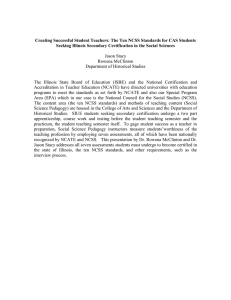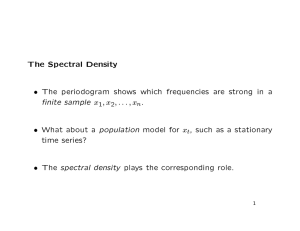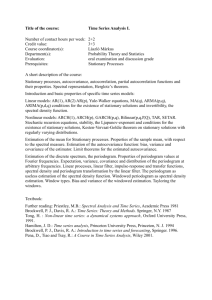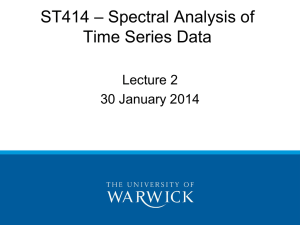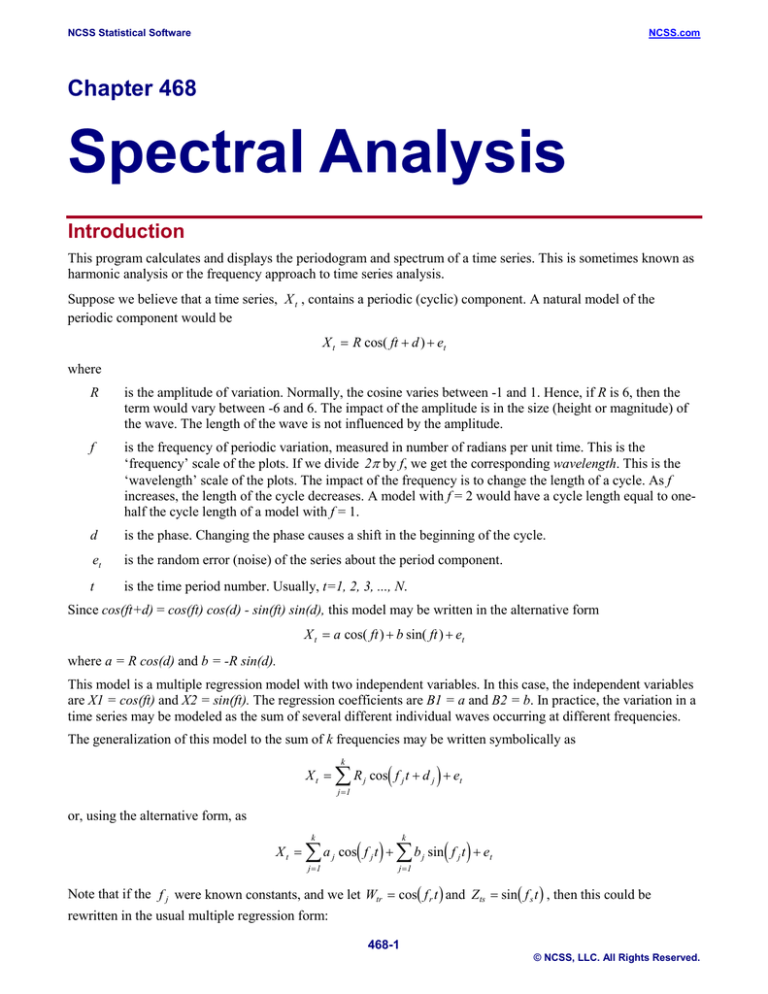
NCSS Statistical Software
NCSS.com
Chapter 468
Spectral Analysis
Introduction
This program calculates and displays the periodogram and spectrum of a time series. This is sometimes known as
harmonic analysis or the frequency approach to time series analysis.
Suppose we believe that a time series, X t , contains a periodic (cyclic) component. A natural model of the
periodic component would be
X t = R cos( ft + d ) + et
where
R
is the amplitude of variation. Normally, the cosine varies between -1 and 1. Hence, if R is 6, then the
term would vary between -6 and 6. The impact of the amplitude is in the size (height or magnitude) of
the wave. The length of the wave is not influenced by the amplitude.
f
is the frequency of periodic variation, measured in number of radians per unit time. This is the
‘frequency’ scale of the plots. If we divide 2π by f, we get the corresponding wavelength. This is the
‘wavelength’ scale of the plots. The impact of the frequency is to change the length of a cycle. As f
increases, the length of the cycle decreases. A model with f = 2 would have a cycle length equal to onehalf the cycle length of a model with f = 1.
d
is the phase. Changing the phase causes a shift in the beginning of the cycle.
et
is the random error (noise) of the series about the period component.
t
is the time period number. Usually, t=1, 2, 3, ..., N.
Since cos(ft+d) = cos(ft) cos(d) - sin(ft) sin(d), this model may be written in the alternative form
X t = a cos( ft ) + b sin( ft ) + et
where a = R cos(d) and b = -R sin(d).
This model is a multiple regression model with two independent variables. In this case, the independent variables
are X1 = cos(ft) and X2 = sin(ft). The regression coefficients are B1 = a and B2 = b. In practice, the variation in a
time series may be modeled as the sum of several different individual waves occurring at different frequencies.
The generalization of this model to the sum of k frequencies may be written symbolically as
Xt =
k
∑R
j =1
j
(
)
cos f j t + d j + et
or, using the alternative form, as
Xt =
k
∑
( ) ∑ b sin( f t ) + e
k
a j cos f j t +
j =1
j
j
t
j =1
Note that if the f j were known constants, and we let Wtr = cos( f r t ) and Zts = sin( f s t ) , then this could be
rewritten in the usual multiple regression form:
468-1
© NCSS, LLC. All Rights Reserved.
NCSS Statistical Software
NCSS.com
Spectral Analysis
Xt =
k
∑
a jWtj +
k
∑b Z
j
tj
+ et
j =1
j =1
where the a’s and the b’s are the regression coefficients to be estimated. This is an example of a harmonic
regression.
Fourier analysis is the study of approximating functions using the sum of sine and cosine terms. This sum is
called the Fourier series representation of the function. Spectral analysis is identical to Fourier analysis except that
instead of approximating a function, the sum of sine and cosine terms approximates a time series that includes a
random component. Note that the coefficients (the a’s and b’s) may be estimated using multiple regression.
One question that arises is how to select the frequencies. The highest frequency that can be fit to the data is π .
The lowest is one cycle for the whole length of series, which amounts to a frequency of 2π / N (N is the length of
the series). Hence, one popular choice of frequencies is to select the N/2 frequencies given by
f k = 2πk / N , ( k = 1, 2, , N / 2 )
The kth frequency is often referred to as the kth harmonic.
This set of frequencies is particularly popular when working by hand because it results in certain simplifications
due to well-known trigonometric identities. However, there is nothing in nature that says that a series will follow
these rather than some other set. That is why the program lets you specify a range of frequencies.
In the analysis of variance, we study the partitioning of the total variation (sum of squares) given by
SST =
N
∑( X
t
−X
t =1
)
2
into the sum of squares for factor A, factor B, etc. Similarly, in spectral analysis we are interested in partitioning
the total sum of squares into amounts associated with each frequency. It turns out that the sum of squares for a
particular frequency, SSk, is given by
SS k =
(
N 2
a k + bk2
2
)
If we regard SSk as the portion of the total sum of squares accounted for by frequencies in the range
fk ±
π
N
,
we can draw a histogram so that the area of each bar is proportional SSk. The height of the histogram would be
I( f k ) =
(
N 2
a k + bk2
4π
)
The plot of I(f) versus f is called the periodogram.
This definition of the periodogram equates the total sum of squares to the area under the periodogram. I(f) may be
calculated directly from the data as
[∑ X
I( f ) =
k
] [∑ X sin(2πkt / N )]
cos( 2πkt / N ) +
2
t
2
t
Nπ
The periodogram is sometimes calculated using the fast Fourier transform (FFT). This method is not used in this
program for three reasons. First, the increase in speed of the FFT is not significant until N is greater than one
thousand. For series of the length we normally anticipate for our users, the FFT would provide little speed
improvement.
Second, when using the FFT, the length of the series (N) must be a power of 2 (2, 4, 8, 16, 32, 64, 128, 256, 512,
1024, etc.). If N is not a power of 2, then enough zeros must be added to bring the length of the series to the next
468-2
© NCSS, LLC. All Rights Reserved.
NCSS Statistical Software
NCSS.com
Spectral Analysis
power of 2. Suppose the length of a particular series was 260. You would need to add 252 zeros to bring the
length to 512. This could dramatically distort your results. (FFT users use various “windows” or “filters” to
remove the effect of these zeros. Since we do not pad with zeros, we do not need these filters.)
Third, we can calculate the periodogram for any set of frequencies, not just the set given above. This is very
useful when you want to investigate a particular range of frequencies.
The sample periodogram has been shown to have some poor statistical properties. Recently, techniques for
spectral analysis have improved on the periodogram by smoothing it. The smoothed periodogram is an estimate of
the power spectral density or simply the spectral density of the series. The smoothing used in this program is
simply an m-term moving average of the periodogram. The value of m is specified as the Smoothing Length
option. Practitioners suggest that a value of m near N/40 is reasonable. A large value of m may make the graph too
smooth while a value too small may include spurious peaks.
Spectral analysis offers an interesting addition to other methods of time series analysis. For those who wish to
find more out about it, we strongly recommend the book by C. Chatfield (1984). It offers a thorough, readable
treatment of a difficult, but useful, subject.
Data Structure
The data are entered in a single variable.
Missing Values
When missing values are found in the series, they are either replaced or omitted. The replacement value is the
average of the nearest observation in the future and in the past or the nearest non-missing value in the past.
If you do not feel that this is a valid estimate of the missing value, you should manually enter a more reasonable
estimate before using the algorithm. These missing value replacement methods are particularly poor for seasonal
data. We recommend that you replace missing values manually before using the algorithm.
Procedure Options
This section describes the options available in this procedure.
Variables Tab
Specify the variable on which to run the analysis.
Time Series Variable
Time Series Variable
Specify the variable on which to run the analysis.
Use Logarithms
Specifies that the log (base 10) transformation should be applied to the values of the variable.
Missing Values
Choose how missing (blank) values are processed.
468-3
© NCSS, LLC. All Rights Reserved.
NCSS Statistical Software
NCSS.com
Spectral Analysis
The algorithm used in this procedure cannot tolerate missing values since each row is assumed to represent the
next point in a time sequence. Hence, when missing values are found, they must be removed either by imputation
(filling in with a reasonable value) or by skipping the row and pretending it does not exist.
Whenever possible, we recommend that you replace missing values manually.
Here are the available options.
Average the Adjacent Values
Replace the missing value with the average of the nearest values in the future (below) and in the past (above).
Carry the Previous Value Forward
Replace the missing value with the first non-missing value immediately above (previous) this value.
Omit Row from Calculations
Ignore the row in all calculations. Analyze the data as if the row was not on the database.
Data Adjustment Options
Remove Mean
Checking this option indicates that the series average should be subtracted from the data. This is almost always
done.
Remove Trend
Checking this option indicates that the least squares trend line should be subtracted from the data. This is
sometimes done, although differencing is usually used to remove trends instead.
Regular Differencing
This option lets you designate whether the original series, the first differences, or the second differences are
analyzed. The first difference series, W, is calculated using the formula:
Wt = X t − X t −1
which may be written using the backshift operator, B, as:
Wt = (1 − B) X t
The second difference series, Z, is the first difference of the W series. The formula is:
Zt = Wt − Wt −1
which may be written using the backshift operator, B, as:
Zt = (1 − B) X t
2
Seasonal Differencing
This option lets you designate whether the original series, the first seasonal differences, or the second seasonal
differences are analyzed. Assuming the number of seasons is s, the first seasonal difference series, W, is
calculated using the formula:
Wt = X t − X t − s
which may be written using the backshift operator, B, as:
(
)
Wt = 1 − B s X t
The second seasonal difference series, Z, is the first seasonal difference of the W series. The formula is:
468-4
© NCSS, LLC. All Rights Reserved.
NCSS Statistical Software
NCSS.com
Spectral Analysis
Zt = Wt − Wt − s
which may be written using the backshift operator, B, as:
(
Zt = 1 − B s
)
2
Xt
Seasonality Options
Seasons
Specify the number of seasons, s, in the series. Use ‘4’ for quarterly data or ‘12’ for monthly data. Note that this
option is used only when seasonal differencing is used.
Reports Tab
The following options control which reports are displayed.
Select Reports
Fourier Report
This option specifies whether the indicated report is displayed.
Periodogram / Spectrum Calculation Options
Number of Frequencies
Specify the number of frequencies that are calculated and displayed. This controls the resolution of the
periodogram and spectrum. The frequencies are equi-spaced between the minimum and maximum wavelengths.
Smoothing Length
The spectral density function is a moving average of the periodogram. This option specifies the value of m, the
number of periodogram terms averaged.
Minimum Wavelength
The minimum wavelength value to be used in calculating and displaying the periodogram and spectral density.
Maximum Wavelength
The maximum wavelength value to be used in calculating and displaying the periodogram and spectral density.
The maximum value possible is N, the sample size.
Report Options
Precision
Specify the precision of numbers in the report. Single precision will display seven-place accuracy, while the
double precision will display thirteen-place accuracy. Note that all reports are formatted for single precision only.
Variable Names
Specify whether to use variable names or (the longer) variable labels in report headings.
468-5
© NCSS, LLC. All Rights Reserved.
NCSS Statistical Software
NCSS.com
Spectral Analysis
Plots Tab
This section controls the inclusion and the settings of the plots.
Select Plots
Data Plot - Spectrum
Each of these options specifies whether the indicated plot is displayed. Click the plot format button to change the
plot settings.
Horizontal Axis Variable if there are Missing or
Filtered Values
Horizontal Variable
This option controls the spacing on the horizontal axis when missing or filtered values occur.
Your choices are
Actual Row Number
Use the actual row number of each row from the dataset along the horizontal axis.
Sequence Number
Use the sequence (relative row) number formed by ignoring any missing or filtered values.
468-6
© NCSS, LLC. All Rights Reserved.
NCSS Statistical Software
NCSS.com
Spectral Analysis
Example 1 – Spectral Analysis
This section presents an example of how to do a spectral analysis of a time series. The Spots variable in the
Sunspot dataset will be used.
You may follow along here by making the appropriate entries or load the completed template Example 1 by
clicking on Open Example Template from the File menu of the Spectral Analysis window.
1
Open the Sunspot dataset.
•
From the File menu of the NCSS Data window, select Open Example Data.
•
Click on the file Sunspot.NCSS.
•
Click Open.
2
Open the Spectral Analysis window.
•
Using the Analysis menu or the Procedure Navigator, find and select the Spectral Analysis procedure.
•
On the menus, select File, then New Template. This will fill the procedure with the default template.
3
Specify the variables.
•
On the Spectral Analysis window, select the Variables tab.
•
Double-click in the Time Series Variable box. This will bring up the variable selection window.
•
Select Spots from the list of variables and then click Ok.
4
Run the procedure.
•
From the Run menu, select Run Procedure. Alternatively, just click the green Run button.
Fourier Plot Section
468-7
© NCSS, LLC. All Rights Reserved.
NCSS Statistical Software
NCSS.com
Spectral Analysis
This section displays the periodogram and the spectrum plots with the frequency scale and the wavelength scale.
Remember that the wavelength is in terms of the number of observations.
Data Plot Section
This section displays a plot of the data values.
468-8
© NCSS, LLC. All Rights Reserved.
NCSS Statistical Software
NCSS.com
Spectral Analysis
Fourier Analysis Section
Fourier Analysis of SPOTS (0,0,12,1,0)
Frequency
Wavelength
Period
0.2010619
31.25
3200767
0.2764601
22.72727
324968.6
0.3518584
17.85714
4330590
0.4272566
14.70588
3856917
0.5026549
12.5
4814120
.
.
.
.
.
.
.
.
.
Cosine(a's)
-75.89938
-13.48533
92.67065
33.71187
298.3864
.
.
.
Sine(b's)
-425.8151
137.1568
-494.4972
-473.5963
-438.5685
.
.
.
Sprectrum
3590384
2618775
2837492
4333876
2.997943E+07
.
.
.
This section shows the values of the various components of the spectral analysis. The numbers in parentheses,
(d,D,s,M,T), are defined as follows:
d
is the regular differencing order.
D
is the seasonal differencing order.
s
is the number of seasons (ignored if D is 0).
M
is 1 if the mean is subtracted, 0 otherwise.
T
is 1 if the trend is subtracted, 0 otherwise.
Fourier Plot Section
To complete this example, we rerun the analysis with the minimum wavelength set to 8 and the maximum wavelength
set to 15. This appears to be portion of the periodogram and spectrum that show the most promise. Doing this
produces the following wavelength plots.
Now we can see the famous sunspot cycle of just over eleven years.
468-9
© NCSS, LLC. All Rights Reserved.

